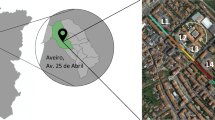Abstract
This paper established the urban road vehicle emission pollution evaluation model based on multi-user dynamic network traffic flow distribution, this model used the method of unit cell transfer, simulated mixed models of microcosmic running characteristics on the urban traffic network, and at the same time, it realized the dynamic network traffic flow of the users optimal distribution, it also can output the network traffic flow when reached to the users optimal operation state, each section and all kinds of models in every time, every area of the speed and flow, by combining exhaust emission model to analyze on network the motor vehicle exhaust emission pollution condition.
Access this chapter
Tax calculation will be finalised at checkout
Purchases are for personal use only
Preview
Unable to display preview. Download preview PDF.
Similar content being viewed by others

References
Wong, G.C.K., Wong, S.C.: A multi-class traffic flow model-an extension of LWR model with heterogeneous drivers. Transportation Research A 36, 827–841 (2002)
Daganzo, C.F.: The cell transmission model part II: network traffic. Transportation Research B 29, 79–93 (1995)
Boel, R., Mihaylova, L.: A compositional stochastic model for real time freeway traffic simulation. Transportation Research B 40, 319–334 (2006)
Ran, B., Boyce, D.E.: Modeling dynamic transportation network: an intelligent transportation system oriented approach. Springer, Heidelberg (1996)
Feng, X., Chen, S.: Improve the city road vehicle emission pollution intelligent transportation means. Journal of Traffic and Transportation Engineering 2, 73–77 (2002)
Bliemer, M.C.J., Bovy, P.H.L.: Quasi-variational inequality formulation of the multiclass dynamic traffic assignment problem. Transportation Research B. 37, 501–519 (2003)
Boel, R., Mihaylova, L.: A compositional stochastic model for real time freeway traffic simulation. Transportation Research B. 40, 319–334 (2006)
Kadalbajoo, M.K., Arorar, P., Gupta, V.: Collocation method using artificial viscosity for solving stiff singularly perturbed turning point problem having twin boundary layers. Computers and Mathematics with Applications 61, 1595–1607 (2011)
Wang, R.-H., Li, C.-J., Zhu, C.-G.: Computational Geometry. Science Press, BeiJing (2008)
Ren, Y.-J.: Numerical Analysis and MATLAB Implementation. Higher Education Press (2008)
Author information
Authors and Affiliations
Editor information
Editors and Affiliations
Rights and permissions
Copyright information
© 2011 Springer-Verlag Berlin Heidelberg
About this paper
Cite this paper
Lian, A. (2011). Motor Vehicle Emission Pollution Evaluation Model Based on Multi-user Dynamic Network. In: Liu, C., Chang, J., Yang, A. (eds) Information Computing and Applications. ICICA 2011. Communications in Computer and Information Science, vol 243. Springer, Berlin, Heidelberg. https://doi.org/10.1007/978-3-642-27503-6_80
Download citation
DOI: https://doi.org/10.1007/978-3-642-27503-6_80
Publisher Name: Springer, Berlin, Heidelberg
Print ISBN: 978-3-642-27502-9
Online ISBN: 978-3-642-27503-6
eBook Packages: Computer ScienceComputer Science (R0)



